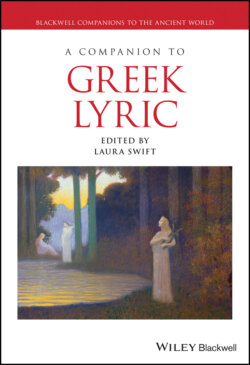Читать книгу A Companion to Greek Lyric - Группа авторов - Страница 33
III Eos and Tithonos across the Modes
ОглавлениеMost of the time, we don’t have directly comparable treatments of the same tale, which makes particularly valuable the widespread story of the goddess Eos and her Trojan husband Tithonos. In this tale, Eos falls in love with the handsome mortal Tithonos and asks Zeus to make him immortal. Known from several early sources (and assumed in Homer’s formular expressions for daybreak, where Eos simply rises from Tithonos’ side: Il. 11.1–2, Od. 5.1–2), here we can compare three lyric treatments (Tyrtaeus fr. 12.5 W, Mimnermus fr. 4 W, Sappho fr. 58) with an epic one (Homeric Hymn to Aphrodite 218–240). For Tyrtaeus, Tithonos is a one-line, almost throwaway, paradigm of beauty (“not even if he were more fair than Tithonos”);17 for Mimnermus, in an isolated and lacunose couplet from his longer elegiac poem Nanno (“to Tithonos [Zeus] gave an everlasting evil/old age, which is more dreadful than terrible death”), aging immortality is even worse than death. Similarly brief, but at least with some contextual detail as to its point, Sappho’s fr. 58 adduces Tithonos’ example, as mortal lover of Eos, to parallel her own aged situation and relationship to Music (vv. 2–7), in contrast to an opening exhortation to unspecified “children” to cultivate the Muses (1–2): she cannot escape old age (6–7), illustrating her point by reference to the state which takes him despite his divine consort (8–12). Her selectivity and allusivity is clear (nb. the reference to tradition in the form ἔφαντο “they said” 9),18 as is the deployment of several apparently epic features, such as the expression for Dawn (βροδόπαχυν Αὔων “rosy-armed Dawn” 9) which looks like a Lesbian recreation of the (later attested) epic phrase of the same meaning Ἠῶ τε ῥοδόπηχυν (HH 31.7), but must be a “new” coinage, given that this epithet is never applied in early epic to Dawn (see Hes. Th. 246, 251, fr. 35.14 M–W, etc.).19
Tithonos as a negative example is found once more in the epic hymn, where Aphrodite explains to Anchises why their liaison cannot be permanent:20 as in Sappho, the relationship between Eos and Tithonos has an exemplary purpose, but the story proceeds in a more leisurely way and sequentially, each activity being fully told before the next: from the first snatching (218–219) all the way to Dawn’s final abandonment of him in the closed bedroom (233–238). Aphrodite then goes on to draw lessons from the story as reasons for them not to be together, in somewhat the way Sappho had tried to link the story with her circumstance (though here at the end rather than the start of the myth), but the differences in scale and process between epic and lyric modalities are clear: the epic speaker/narrator proceeds step-by-step and gives the whole story, in this case within a broader, embedding narrative encounter between goddess and heroic mortal, while the lyricist’s smaller composition selects and alludes only to the desired parts of that story—an excellent example of the general lyric approach to the “epic” material in the Archaic period.
